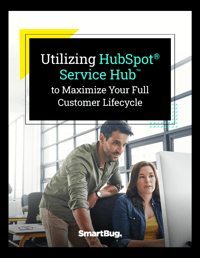.png?width=1180&name=Untitled%20design%20(26).png)
Delving into the Voice of the Customer: Expert Tips for Measuring and Analyzing Customer Feedback
February 16, 2024
By Paul Schmidt
What makes customer feedback so important? Collecting feedback allows us to delve into the voice of the customer, giving us access to an invaluable point of view. Businesses can leverage customer feedback tools and performance metrics to maximize delight, brand loyalty, and retention.
Customer feedback is also important for building trust and credibility with a customer base. When companies share and publicize good feedback, it builds up their brand image and reputation. Even receiving criticism can give the brand an opportunity to address the issue and perhaps mitigate it. This contributes to increased customer loyalty and better retention.
Every business can benefit from customer feedback—but how can your business listen to your customers’ voices and turn that feedback into the benefits described above? We’ve got all the tips you need.
Popular Customer Feedback Platforms and Methods
What are we looking to learn or achieve with customer reviews? How you answer will likely dictate the avenue you take for collecting customer feedback. The ideal customer feedback platform for your audience will depend on the specifics of your business model, but here are five classic techniques for measuring customer sentiment:
- Surveys and questionnaires: Digital surveys, usually distributed through email or presented directly on websites, allow for highly targeted questions that meet your customers where they are: online.
- Social media monitoring: Regularly engaging with customers on social networks and monitoring social channels can provide businesses with real-time, honest feedback from a wide range of demographics.
- Focus groups and interviews: In-depth discussions with a select group of customers or tailored one-on-one interviews can yield qualitative insights. In either case, these methods allow you to experience your offering from an individual customer’s perspective.
- User testing: Another way to see things from your customers’ point of view, this method of gathering feedback involves observing customers while they use your product or service in a controlled environment.
- Feedback forms and rating systems: Easy-to-access forms on websites or apps encourage spontaneous, candid feedback from customers while the experience is fresh in their minds. Similarly, online reviews and ratings give valuable insights into customer satisfaction levels.
Effective Customer Feedback Tools
Dozens of customer feedback tools that apply to a range of markets and industries are available to today’s businesses. The mechanism you ultimately choose to host a customer feedback initiative will depend largely on your target audience and business objectives, but a few widely used customer feedback tools include:
- Survey tools: HubSpot Service Hub, SurveyMonkey, and Google Forms are a few easy-to-use tools for creating and distributing surveys.
- CRM systems: After choosing a mechanism for collecting survey data, you need to make sure you can easily integrate it into your CRM so you’ll have a 360-degree view of the customer.
- Social media tools: HubSpot and Hootsuite help you easily monitor customer feedback across a range of online channels. Similarly, you’ll want to make sure any valuable social media data is actively flowing into your CRM.
- Analytics tools: HubSpot Analytics, Google Analytics, Lucky Orange, and Hotjar are all programs that can offer you more direct usage data.
Considerations When Gathering Customer Feedback
To get comprehensive feedback, it’s important to get answers from as many types of customers as possible. Businesses must use varied channels, targeted outreach, and inclusive design.
First, employ a mix of approaches for compiling feedback. For example, you might collect feedback via email surveys, social media polls, and focus groups simultaneously to broaden your reach. This approach can be augmented with targeted outreach, which involves reaching out directly to underrepresented groups in your customer base to further diversify responses.
Finally, ensure feedback tools are accessible to all customers, and feature inclusive design elements. Examples of these considerations include allowing for easy language translation and accommodating those with disabilities or impairments.
Gathering customer feedback can be a bit tricky in certain situations and in some industries. For example, some highly technical or niche markets may require specialized methods for collecting meaningful feedback, such as expert interviews. These interviews can be incredibly valuable, but they must be developed and curated with care and intention.
Moreover, healthcare, legal, and other personal service industries tend to have more privacy considerations than other markets because responses could contain personal or confidential information. In these instances, it’s important to be clear and careful with wording in feedback prompts. In some cases, it will be best to only ask questions with fixed responses (e.g., multiple choice or rating on a scale) as opposed to open-ended questions that allow opportunities to share sensitive info. If open-ended responses are necessary, ensure they are captured and stored using secure encryptions.
How to Analyze Customer Feedback and Measure Success
Access to vast amounts of customer sentiment data and detailed reviews is only valuable if you can interpret and contextualize that data. In other words, to contribute to your bottom line, the data must have meaning. How can you leverage the intelligence you receive from feedback initiatives to make your business better?
Analyzing Customer Feedback
One inherent challenge when analyzing feedback is differentiating between general or nonspecific opinions and constructive criticism. To keep your focus on the latter, look for specifics and assess actionability. Constructive feedback usually contains specific points rather than vague opinions. Any feedback that offers solutions or specific points to a clear problem also tends to be more constructive.
Also, always consider the source of the feedback. Input from engaged customers or those with relevant expertise often proves most valuable. Consider this: As a prospective buyer, would you rather hear an opinion about a product from someone who has never used it, or from a small business owner who uses the product daily to create their merchandise?
Measuring Success
Much of the feedback customers offer is qualitative, which can make measuring the success of an initiative slightly more complex. But by quantifying what they can and identifying key performance indicators (KPIs), businesses can objectively assess the performance of their feedback initiatives. Some examples of these metrics include:
- Net Promoter Score (NPS): Measures customer loyalty and likelihood of recommending your offering
- Customer satisfaction score (CSAT): Assesses short-term satisfaction with a product or service
- Customer effort score (CES): Evaluates the ease of interaction with the brand
- Feedback response rate: Calculates the percentage of customers who provide feedback after a request
One of the most important reasons to implement formal processes for gathering feedback is that it can help improve retention and increase upsell opportunities. Businesses should monitor relevant churn and revenue metrics before and after implementing these kinds of programs to evaluate their impact.
Once you have your preferred customer feedback mechanisms in place, don’t forget to regularly re-evaluate their effectiveness. Natural times to do this evaluation include after any major organizational changes and in response to major market shifts, and it’s a good idea to schedule regular internal reviews even when there haven’t been any big changes.
Making the Most of Customer Feedback Tools
Whether you’re looking to make your website more user-friendly or implement product design updates, customer feedback tools can offer insight into countless areas of business. As long as feedback initiatives are developed in the best interest of the brand, the insights they yield can unlock unlimited potential for your business.
Looking for even more ways to boost customer satisfaction and retention? Set your business up to create a unified customer journey from prospect to renewal with help from SmartBug’s team of experts.

About the author
Paul Schmidt is a director of services strategy at SmartBug Media. He previously worked at HubSpot, helping develop inbound strategies for over 200 clients. His past clients include: Travelers Insurance, Unilever, and the SABIAN Cymbal Company. Paul studied percussion in Las Vegas and got his MBA in marketing in Boston Read more articles by Paul Schmidt.










-4.png?width=800&length=800&name=Untitled%20design%20(1)-4.png)